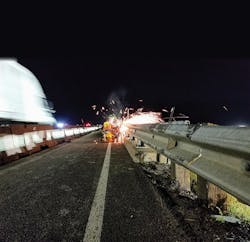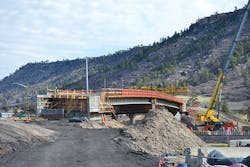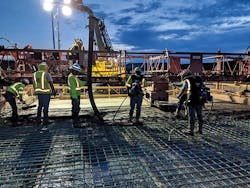Here are some items not typically found on your average highway construction project:
An on-site project operations center staffed seven days per week, portable/variable speed limit signs, four highway underpasses designed to allow wildlife to safely cross under the highway, a project-specific website and Facebook page, 250,000 linear ft of temporary concrete barrier, increased speed enforcement on the ground and by aircraft, and collaborative bi-weekly meetings with emergency first responders. Then again, if you take a drive between Denver and Colorado Springs on I-25, you will realize the highway construction project currently underway is anything but average.
In September 2018, the Colorado DOT (CDOT) broke ground on the I-25 South Gap project. General contractor Kraemer North America teamed with Street Smart, which manages the Smart Work Zone equipment and integration, on the $350 million project funded by CDOT. This 18-mile stretch of road between Monument and Castle Rock is the final section of roadway requiring widening between the state’s two largest cities. It is traveled by over 80,000 motorists each day and has not seen significant improvements since 1950. It is the longest work zone in the state, with an expected completion date in fall 2022.
Increased capacity and safety
This stretch of roadway has seen a sharp increase in traffic over the past decade due to population growth, leading to an increase in daily traffic volumes and crashes. Between 2011 and 2015, there were more than 5,500 crashes recorded. The highway consisted of just two general-purpose lanes in each direction with extremely narrow shoulders, creating unsafe conditions for drivers and emergency response providers. The overall width of the asphalt surface varied 38 ft to 44 ft in each direction. Upon completion, motorists will enjoy a more reliable trip with an express lane in each direction, two general-purpose lanes, and wider shoulders. The final width of asphalt through the entire project will be 63 ft to 80 ft of road in each direction of travel with improved vertical and horizontal curves.
In addition, five bridges are being reconstructed and exit/entrance ramps are being improved. A southbound climbing lane will be added to allow for slower-moving trucks to safely ascend Monument Hill, the highest point on I-25 within Colorado, without slowing traffic. Crews also will construct four new wildlife underpasses and install 24 miles of wildlife fencing, which will result in decreased collisions between vehicles and wildlife.
The work was divided into three sections and utilized a unique design process that allowed for the first section to commence before design on subsequent sections was even finalized. This approach allowed the project to start much earlier than anticipated. An average of 300 workers can be found on the jobsite at any given time, and work is taking place 24 hours a day, including weekends.
Smart technology
Protecting construction workers and providing notifications to motorists to increase safety and calm the flow of traffic has been a top priority of the project. Various Smart Work Zone systems are in use and work concurrently to reduce speeds and crashes while increasing safety. By definition, a Smart Work Zone is a customized grouping of integrated traffic safety devices and software that dynamically displays real-time information to motorists traveling through construction zones. Used at an increasing rate within road construction projects across North America, the defining characteristic of Smart Work Zones is their ability to be tailored to any size or type of road improvement project and, as experienced within the I-25 corridor, customized according to the various phases of construction to create the safest environment for workers and motorists.
Mike Granger Jr., president of Street Smart, noted, “Over the past 7-8 years, CDOT has become one of the country’s pioneering DOTs in terms of incorporating innovative solutions and technology to create safer highway work zones, as this I-25 project can certainly attest. The CDOT team and its construction partners have truly raised the bar and taken Smart Work Zones to the next level with this project. Never before has a project included trucks entering/exiting warning systems, queue warning systems, travel time systems, CCTV trailers, data collection systems, variable speed limit signs, and smart variable speed limit trailers all working in unison to protect workers and motorists within a single work zone. It’s been a fun challenge for our team, and the safety results achieved through the use of these various technologies is something everyone involved in the project should be extremely proud of.”
The Smart Work Zone systems found within this project include:
Trucks Entering / Exiting Highway System: With an average of three construction trucks entering or exiting I-25 every five minutes, trailer-mounted speed sensors detect slow-moving trucks and notify motorists via electronic message board, in real-time, when trucks are entering or exiting the highway, providing adequate time for motorists to decrease speeds or give way to trucks. This configuration is more effective than traditional “trucks entering/exiting” static signs since the warning message is displayed only when applicable conditions are met. Jeff Stevenson, a project engineer for Kraemer, commented on the effectiveness of this system: “Access entering and exiting the interstate was challenging for our crews. We appreciate CDOT’s commitment to safety on this project and the additional efforts made to warn motorists of these slow-moving vehicles.”
Queue Warning System: Rear-end collisions are the most common type of crashes within highway work zones. Trailer-mounted traffic data collection sensors transmit real-time information via cellular connection to large electronic message boards, alerting motorists of slow or stopped traffic if pre-defined conditions are met. Studies have shown a 45% reduction in rear-end collisions when queue warning systems are incorporated into traffic management plans.
Travel Time Systems: With 80,000 daily vehicles, varied Colorado weather patterns, and planned and unplanned lane closures, the time it takes to pass through the work zone changes throughout the day. Traffic data collection sensors track and display real-time “travel times” (i.e., “10 Miles / 12 MIN”) on electronic message boards. This information allows motorists to know how quickly, or slowly, they will be traveling through the work zone.
Advisory Messages: Crashes, detours, special event notifications, and other relevant information can be displayed and communicated in real-time on the electronic message boards.
Traffic Camera Trailers: Mounted 30 ft in the air, solar-powered cameras allow traffic conditions to be monitored from the central Project Operation Center. Stalled vehicles, crashes, and other situations can be identified quickly, allowing appropriate action to be taken to help minimize traffic impacts, as guided by these additional cameras positioned within the project.
Data Collection: CDOT places a strong emphasis on data collection within the work zone and uses it to make decisions to increase safety. Sensors are strategically placed along the 18 miles of roadway with the speeds of virtually every vehicle passing through collected and analyzed through Ver-Mac’s Jam Logic software. Automated reporting allows for on-site engineers to identify hotspots or to make predictive decisions based on historical traffic trends.
Negar Karimi with CDOT’s Region 1 Traffic & Safety, Construction Unit, noted, “Data collected by our Smart Work Zone systems— including speed, volume, queuing time, and day—helps us make informed decisions for our project. These decisions include (but are not limited to) identifying speeding locations and sharing it with our engineers and law enforcement officers to position their traffic calming team. Also, during COVID-19 stay-at-home orders, we monitored traffic daily using these devices, as no historical data had similar patterns to guide us. With a better understanding of traffic patterns, we were able to grant daytime lane closures to the contractor to mitigate the impact of COVID-19 to our schedule.”
Portable Variable Speed Limit (PVSL) System: Speed is the number one factor in work-zone crashes. CDOT requested a variable speed limit system to reduce vehicle speeds. These trailer-mounted electronic signs display enforceable speed limits to motorists. When workers are present, the project team can reduce the speed limits, typically by 10 mph. During inclement weather or crashes, speeds can be reduced further to calm traffic. A total of 22 PVSL trailers are being used on the project.
Smart Portable Variable Speed Limit Trailers: The Street Smart team and Ver-Mac partnered to manufacture the first-of-its-kind variable speed limit trailer + speed feedback system. The defining characteristic of this hybrid setup is that it displays the current speed of the approaching vehicle. If the driver is traveling up to 10 mph over the posted speed, their speed flashes on the screen. If speeds exceed the posted speed limit by 11+ mph, the current speed is displayed, and small strobing red/blue emergency lights are activated. Automated logic updates these settings if the speed limit is changed. Eight Smart PVSL trailers are deployed, and moved around the construction zone, as needed.
Captain J.P. Burt, Colorado State Patrol Troop 1C & 1B Commander, attested to the effectiveness of these systems: “Having patrolled within highway work zones as part of my duties over my 18-year career, I can say that this project is the largest and smoothest I’ve ever experienced. Much of this can be attributed to the Smart Work Zone technologies that are in place. The variable speed limit systems have led to a reduction in rear-end collisions and have been an extremely effective tool to calm traffic within the work zone.”
A Comprehensive Commitment to Safety
Along with the Smart Work Zone systems, the collaboration between all stakeholders has led to some innovative solutions and increased safety. Every two weeks CDOT, Kraemer, Street Smart, and representatives from over a dozen first-responder agencies meet in an open forum discussion to review traffic incident management response, emergency access points, and upcoming construction schedules. Captain Burt sees great value to these meetings: “The bi-weekly meetings are a time to make and implement real-time safety improvements as needed without any of the red tape typically associated with projects of this scale. From the very beginning, safety within this project work zone has been the primary concern. Deadlines and timelines are secondary to safety. There’s no doubt that the collaboration between law enforcement, first responders, CDOT, Kraemer, and Street Smart have reduced crashes and saved lives within the work zone.”
A few of the innovative safety solutions that have been implemented as a result of these meetings include:
- The on-site operations center can communicate directly with first responders and project-dedicated tow trucks via two-way radios to clear incidents quickly.
- Emergency responders and crews frequently drive the construction zone to identify and reposition materials, barriers, and equipment as needed to ensure prompt emergency response.
- Live-action training sessions between police/fire and construction crews to plan for emergencies.
- If Smart Work Zone trailers need to be added or repositioned, this can happen in a matter of hours.
- To help ease congestion for traffic headed to the popular Colorado Renaissance festival in Larkspur last summer, Kraemer constructed an additional lane on the exit ramp. This annual event draws over 200,000 attendees, and the extra lane prevented queuing on the interstate.
- Increased communications to the public on upcoming project schedules and significant changes to traffic flow, including a text alert system.
Increased safety within the I-25 project has not been the result of one single factor, but rather a collaboration between all stakeholders involved on the project and the Smart Work Zone systems in place, allowing rapid construction to take place while motorists stay informed of what is ahead of them.



